From mist-shrouded mountain peaks to emerald rice terraces cascading down hillsides, the Northwest Vietnam region beckons adventurers and culture enthusiasts alike.
Let's discover the amazing charm of Northwest Vietnam, the unknown beauty with the combination of majestic nature and richly colored cultural tapestry. In this blog, we will lead you into magic Northwest Vietnam, showing why this place should be a priority on your travel list and what unforgettable experiences are waiting for you in this land of wonders.
1. About Northwest Vietnam
Northwest Vietnam is a work of art, a harmonious combination between the grand and poetic beauty of Vietnam. Talking about the Northwest, we must mention the towering mountain ranges, the vast plains covered with a sea of young green rice embracing small villages, the crystal-clear streams gently flowing and singing love songs of the mountains and forests, along with the artistic terraced rice fields adorning the hillsides.
It is a condensation of all the most valuable ethnic cultural treasures, including poetic and soft Xoe dance, resounding melody of the Khen flute sounding over hills and mountains. If the traveler wants to fully appreciate and feel all the majesty and romance of the Northwest Vietnam landscape, we recommend including destinations: Nghia Lo - Tu Le - Mu Cang Chai - Dien Bien - Lai Chau - Sapa - Bac Ha - Thac Ba in your trip.
These places offer the complete journey through the most stunning landscapes of Northwest Vietnam, along with its rich cultural tapestry, enabling a visitor to soak in all the natural wonders and peculiar heritage preserved here.
2. Places to visit in Northwest Vietnam
2.1. Muong Lo Valley, Nghia Lo town
Muong Lo Valley is the second largest field in the Northwest, after Muong Thanh field. This place is located 80 km west of Yen Bai city and about 200 km from Hanoi. Muong Lo Valley includes several communes of Van Chan district and the entire Nghia Lo town, possessing a beautiful natural picture of wild and fresh land. From a breathtaking aerial perspective, the Muong Lo Valley unfolds like a majestic natural amphitheater. This awe-inspiring landscape paints a vivid masterpiece with majestic cloud-covered mountains surrounded by forest canopy, emerald blue water, and waterfalls pouring from above to the foot of the mountain, then weaving through the fields, golden chains of thousands of white clouds. That is the reason why this is one of the best places to visit in Northwest Vietnam.
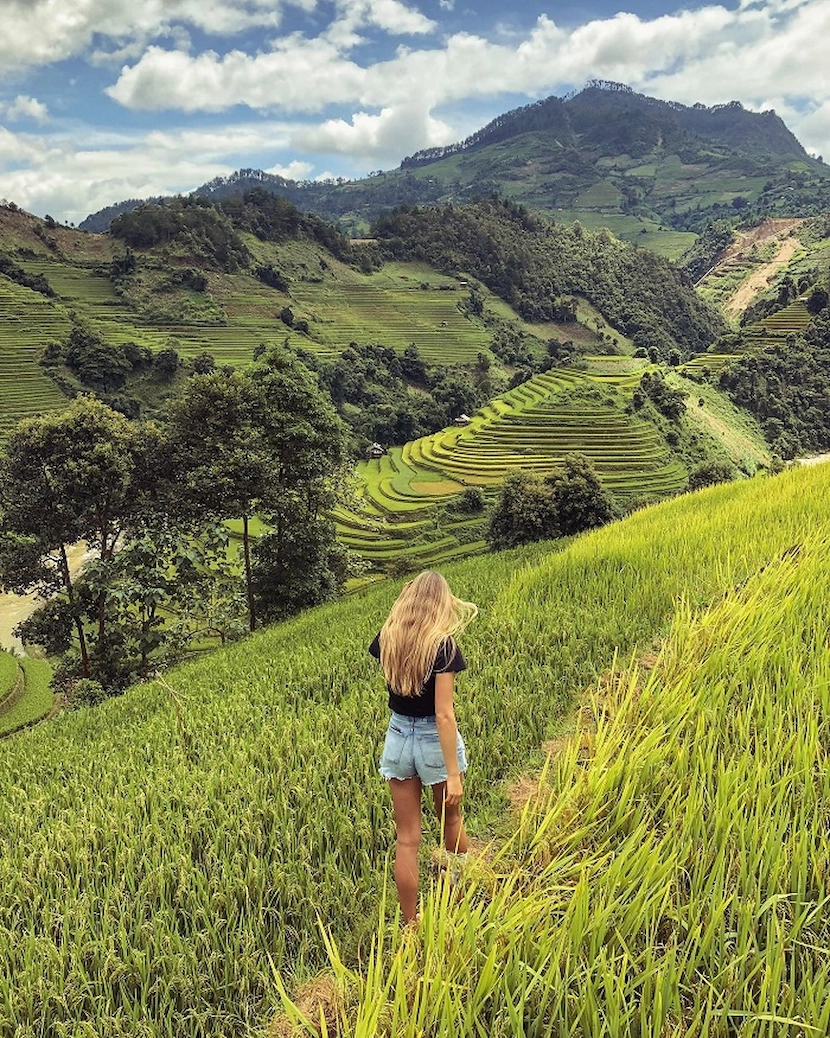
Muong Lo fields are beautiful all year round, but autumn from mid-September to October is the ideal time to explore. This is the most beautiful season for visitors to admire the golden ripe rice fields and join in many local festivals, such as the Season Praying Festival. Coming to Muong Lo, visitors will have the opportunity to stay overnight in large stilt houses, immerse themselves in festivals with the bustling sound of the Khen flute and the Chom Chieng dance in Thai ethnicity colorful, youthful costumes, and enjoy the passionate wine. Not only white rice and festivals full of national identity, but Muong Lo also attracts visitors with its passionate ancient Xoe dances. If you have ever come to Muong Lo but have not been immersed in passionate Xoe dances with Thai girls, then that trip seems incomplete.

To have the most authentic experience with the wild beauty of Muong Lo Valley as well as the local life here, it is highly recommended that you choose to walk around or go on a bicycle and stay overnight at a homestay to try local cooked foods such as grilled dishes made from livestock, poultry, fish, etc. These ingredients are sliced, marinated with spices typical of the Northwest mountains, put on skewers or fresh bamboo clips, and grilled over hot coals, creating an irresistible delicious taste.
2.2. Tu Le Valley
Located close to the Khau Pha Pass, Tu Le Valley, in the Van Chan district of Yen Bai, has long been chosen by many travel enthusiasts to explore when traveling to the Northwest Vietnam region. Tu Le is famous for its wild, poetic beauty of golden terraced rice fields along with peaceful rustic villages and friendly, hospitable people. The most attractive point of this place is the terraced fields of golden ripe rice stretching across the hillsides, creating a picturesque scene. Visitors can admire the terraced rice valley from above or experience walking among the golden ripe rice fields. Not only possessing wild and majestic natural landscapes with towering limestone mountains and winding clear streams, Tu Le is also a community of the Black Thai, Mong, Dao ethnic groups,... living with traditional stilt houses and unique culture. Visitors can go trekking among the rice fields, breathe fresh air, and immerse yourselves in nature.

If you want to admire the unique beauty of terraced fields like a mirror of the sky in the middle of the Northwest mountains and forests, you should choose to go during the Water Pouring Season in Tu Le around May.

But if you prefer to immerse yourself in a golden masterpiece of terraced rice fields, September and October are the best time to visit.
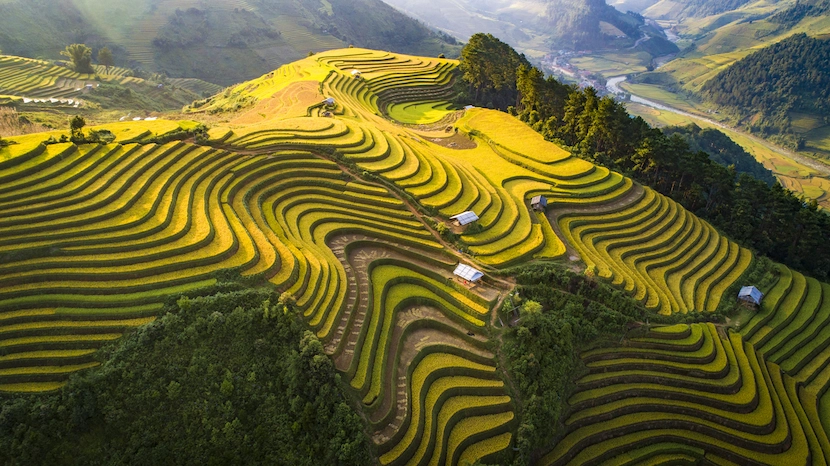
In addition, when coming to Tu Le, you cannot miss the attractive, fresh specialty with the typical flavor of the Northwest mountains and forests: Tu Le com (green rice). Tu Le green rice is made from Tu Le's specialty sticky rice, which is very green, fragrant and sweet. Green rice is often eaten with ripe bananas or made into dishes such as green rice porridge, green rice sticky rice, etc.
2.3. Khau Pha Pass
Khau Pha Pass, like a soft silk strip across the mountains and forests, is also a destination you should not miss when traveling to the Northwest mountainous region of Vietnam. Khau Pha Pass is about 30km long, with an altitude of more than 2,200m, winding around steep cliffs, creating winding and dangerous roads. Conquering Khau Pha Pass is a challenging but also extremely interesting experience for those who love to explore. As one of Vietnam's legendary "four great mountain passes," it boasts a raw, untamed beauty that will leave you breathless. The pass's wild, poetic landscapes are a siren call to nature lovers and photographers alike. Each twist and turn reveals new vistas of mist-shrouded peaks, verdant valleys, and dramatic drop-offs that seem to touch the clouds.
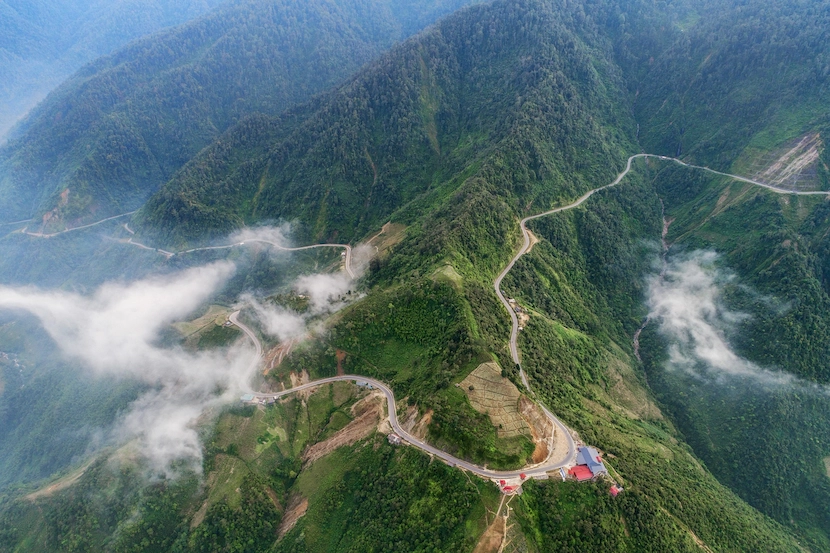
Currently, Khau Pha Pass also has a parachute jumping service from above to the foot of the pass so that visitors can fully explore the beauty of this place. This is an activity that any visitor to Khau Pha Pass should try at least once.
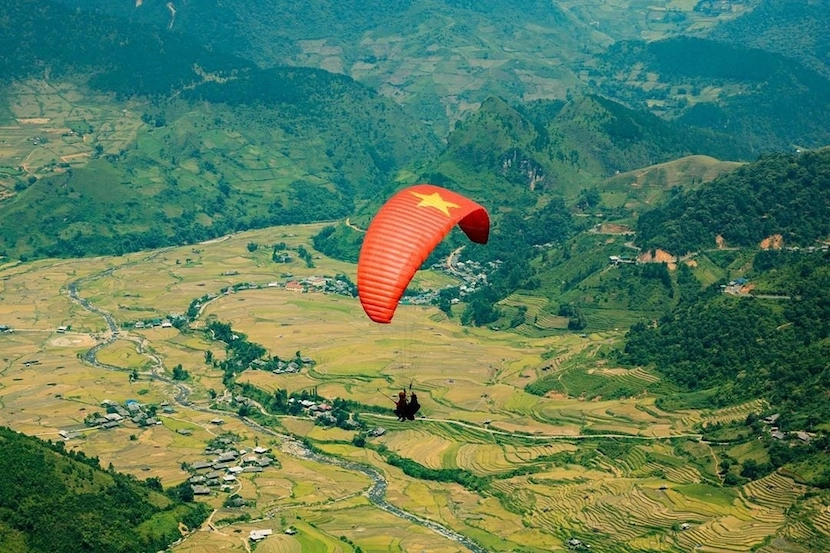
2.4. Mu Cang Chai Rice Terrace Fields
Mu Cang Chai is a hidden gem nestled between two mountain slopes with peaceful villages in a green valley. This destination is one of the best places to visit in Northwest Vietnam and has been recognized as the first Special National Monument of Yen Bai province.

Mu Cang Chai is beautiful all year round. In spring, tender rice seedlings shimmer like emerald jewels on the water's surface. As summer unfolds, the verdant terraces transform hillsides into a mesmerizing green tapestry. The most impressive are the water-pouring season (rice planting season) and the rice ripening season (winter-spring harvest season). The water-pouring season falls from late May to early June, and the terraces are like "mirrors" reflecting the whole world. From September to October is the golden season of Mu Cang Chai, attracting photographers and tourists who want to admire the colorful highland picture. Winter brings its own magic, as the barren fields sketch an ink-painting across the rugged terrain. The end of December is the season of wild peach blossoms.
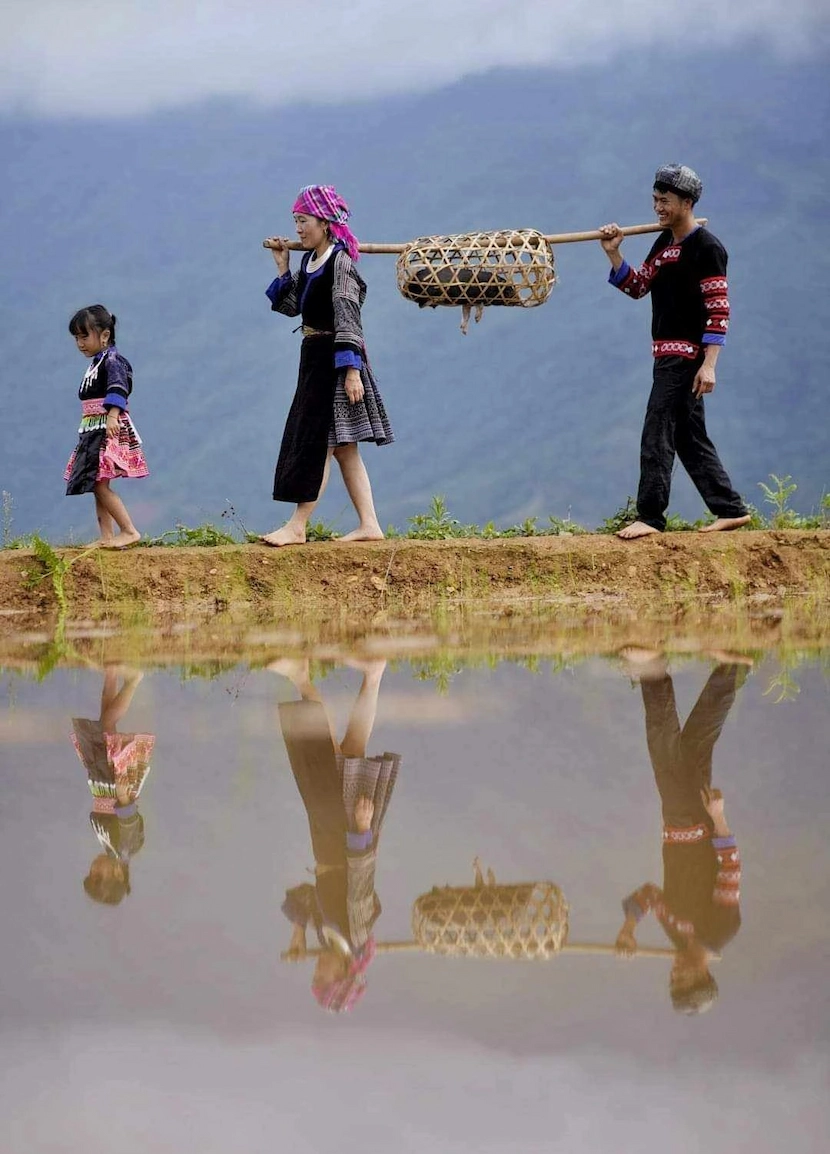
Mu Cang Chai terrace field is the effort created by the Mong people community, who have worked hard for hundreds of years to create and carve into the cliff a great masterpiece with their calloused hands the most majestic picture in the Northwest Vietnam region. The Mong people currently account for more than 90% of the district's population. They live on the high mountain slopes from 800 to 1,700m with traditional and unique cultural features that always attract many researchers. Coming here, visitors can visit Mong ethnic villages, contact with local Mong people, explore the culture as well as the customs and practices of the Northwest highlands with many unique folk cultural and artistic values and famous products. You can watch the Khen dance, join Mong boys and girls at the Sai San festival, experience some traditional crafts such as: forging, weaving with flax, making jewelry, and enjoy the traditional dishes of the Mong people.
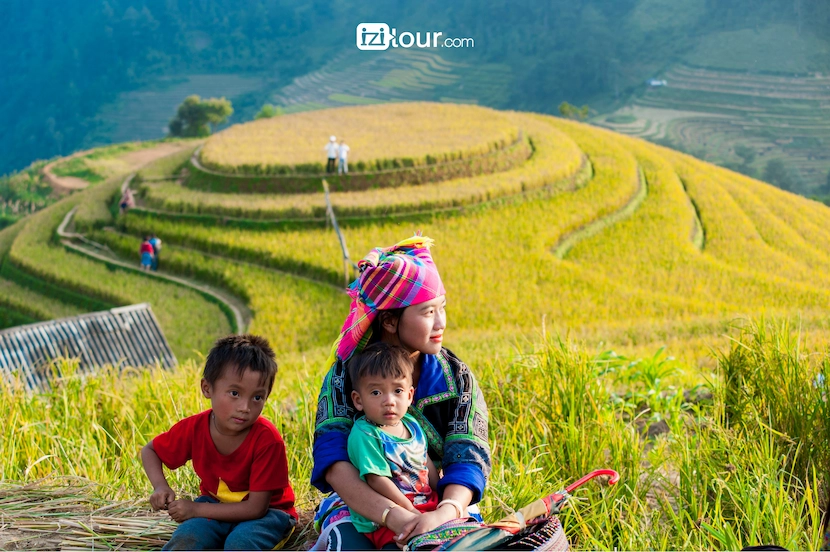
2.5. Dien Bien Phu Historic Sites
Dien Bien Phu is the city of Dien Bien province, located in Northwest Vietnam. When mentioning Dien Bien Phu, we can not help talking about the Dien Bien Phu Campaign, which is the most brilliant milestone in the Vietnamese nation's history as it was Vietnam's greatest military victory in the Indochina War (1945-1954). After 56 days and nights of brave fighting, with intelligence and creativity, on May 7, 1954, the Vietnam People's Army, commanded by General Vo Nguyen Giap, forced the French Army at Dien Bien Phu to surrender after two months of resistance. It can be said that the Dien Bien Phu campaign was a decisive strategic battle, a famous battle that "shook the world", and was the direct cause leading to the signing of the Geneva Agreement on ending the war and restoring peace in Indochina. Moreover, this victory also created the foundation and conditions for our people to continue to win great victories in the resistance war to protect and build the Fatherland later.
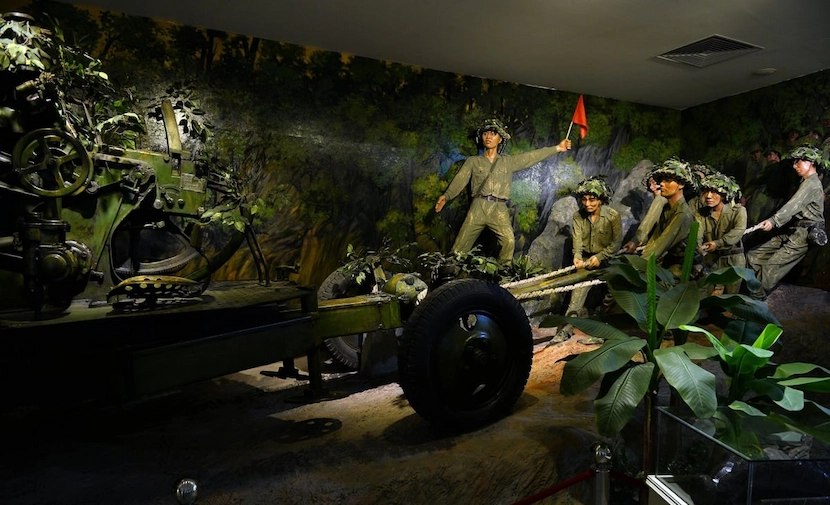
In recent years, Dien Bien in general and Dien Bien Phu Historic Sites in particular have become a tourist destination that always attracts many domestic and international visitors. There are two sites that you can consider to visit: Him Lam Hill and Dien Bien Phu Historical Victory Museum.
- Him Lam Hill: Him Lam relic is an important component of the National Historical Relics of Dien Bien province. This is where the important opening battle took place, contributing to the Dien Bien Phu Victory in 1954.
- Dien Bien Phu Historical Victory Museum: The Dien Bien Phu Historical Victory Museum is a large-scale and most magnificent project in Dien Bien province. This museum is not only of great historical and cultural significance but also an architectural and technical work worthy of the victory that “resounded throughout the five continents and shook the world”.
2.6. O Quy Ho Pass
O Quy Ho Pass is the largest and most beautiful pass in Sapa, and also the longest pass in Northwest Vietnam. The pass is known by many names such as O Quy Ho Pass, Hoang Lien Son Pass or May Pass. Stretching an impressive 50 kilometers along National Highway 4D, O Quy Ho Pass weaves through the magnificent Hoang Lien Son mountain range, bridging the provinces of Lao Cai and Lai Chau. Located at an altitude of 200m above sea level, with dangerous curves and a length of 50km, this pass has made other famous passes such as Ma Pi Leng (20km), Pha Din (32km) or Khau Pha (40km) become small. Perhaps that is why O Quy Ho Pass is known as the "uncrowned king" of the "four great mountain passes" of the Northwest.
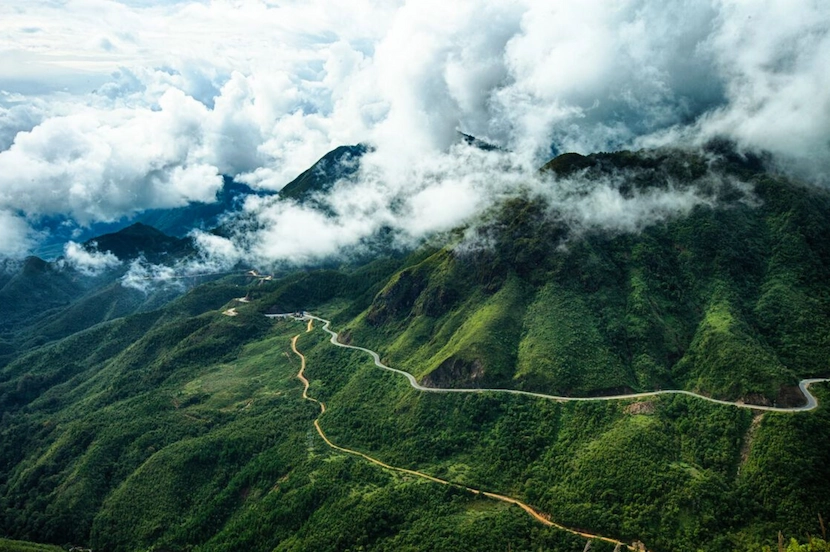
2.7. Sapa Rice Terrace Fields
Located at the foot of the majestic Hoang Lien Son range and just 5-6 hours from Hanoi by highway, Sapa is an ideal year-round destination when visiting Northwest Vietnam.
As winter melts away, spring (February to May) breathes new life into Sapa's landscape. Imagine yourself surrounded by a symphony of colors as cherry, peach, and plum blossoms paint the hillsides in delicate pinks and whites. This floral explosion creates a romantic backdrop perfect for unforgettable photographs and serene nature walks.

Summer from June to August is the time when tourists come to Sa Pa to escape the heat and admire the winding green terraced fields.
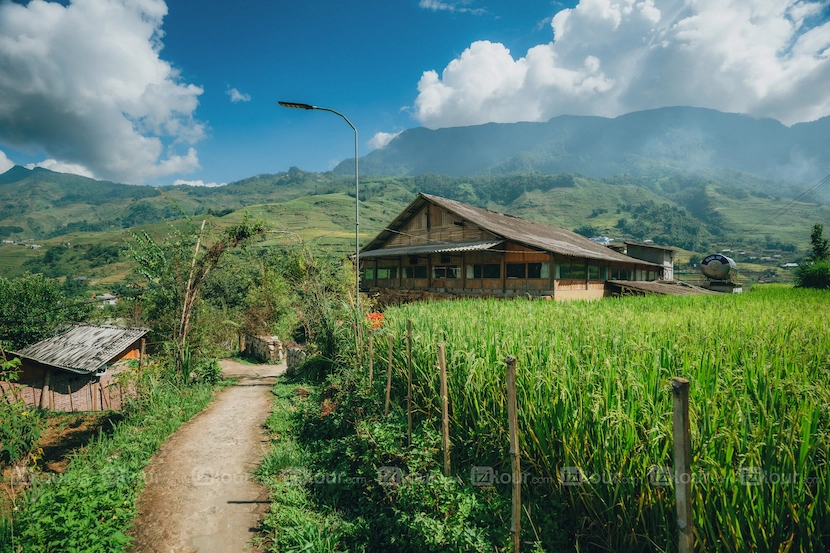
Autumn (September to November) transforms Sa Pa into a golden wonderland. The terraced fields, now ripe with harvest, shimmer in warm, amber tones under the autumn sun. As the air grows crisp, you'll find yourself wrapped in the cozy charm of this mountain retreat.

Winter in Sapa (December to February) brings a touch of magical snow to the mountains, which adventurous souls are always looking for. Imagine waking up early in the morning to find the landscape blanketed in white snow, Sapa has transformed into a winter wonderland. Snow-capped peaks and frost-covered trees create a scene straight out of a fairy tale.
Tourists come here not only to enjoy the fresh air and peaceful countryside of the Northwest region, but Sapa is also a destination for you to admire the wild beauty of terraced fields, waterfalls, majestic mountains, explore the customs, cultural beauty of ethnic groups in the mountains such as: Black H'Mong, Red Dzao, Tay, Dzay, etc.
To explore Sapa terraced fields, you can go trekking in Lao Chai - Ta Van. On both sides, terraced rice and corn fields cascade down the hillsides in an intricate patchwork of emerald and jade. These ancient agricultural marvels, sculpted by generations of skilled farmers, create a living, breathing work of art that changes with the seasons. Although no longer wild and remote, Lao Chai - Ta Van is still a peaceful village with many ethnic groups living there.
See more about Sapa's mesmerizing rice terraces and tranquil ethnic villages:
2.8. Ethnic Markets
When mentioning Northwest Vietnam, people often think of natural beauty but forget that experiencing the ethnic market culture is also a characteristic of this place.
#1 Coc Ly Market
Coc Ly is a highland market in Coc Ly commune, Bac Ha district, Lao Cai province.
Coc Ly market is held every Tuesday. Although it is not a large market, Coc Ly is very important to the ethnic minorities of Bac Ha. This is a meeting place, exchange, and trade of the Mong Hoa, Dao Khuyen (Black Dao), and Nung people. The goods sold at the market are local products and utensils from the lowlands or imported from other regions.

#2 Sin Cheng Market
Sin Cheng Market is located in the center of Sin Cheng Commune, Si Ma Cai District, Lao Cai Province. The market is held every Wednesday. The market is a gathering place for many ethnic groups in Si Ma Cai District and other districts of Lao Cai Province to exchange, trade and trade. There are many items for sale, from brooms made of sugar cane to agricultural products and pets, especially nightingales.
#3 Lung Khau Nhin Market
Lung Khau Nhin Market is held every Thursday morning. Like any other highland market in Sapa, Lung Khau Nhin impresses visitors with the bright colors of fabrics, brocades, and fresh wild flowers that seem to have just been picked from the mountains. Market participants are mostly H'Mong, Kinh, and Man ethnic groups and a few are tourists from quality travel companies or self-going visitors. The market also sells household necessities, poultry, and processed foods to serve daily eating needs.
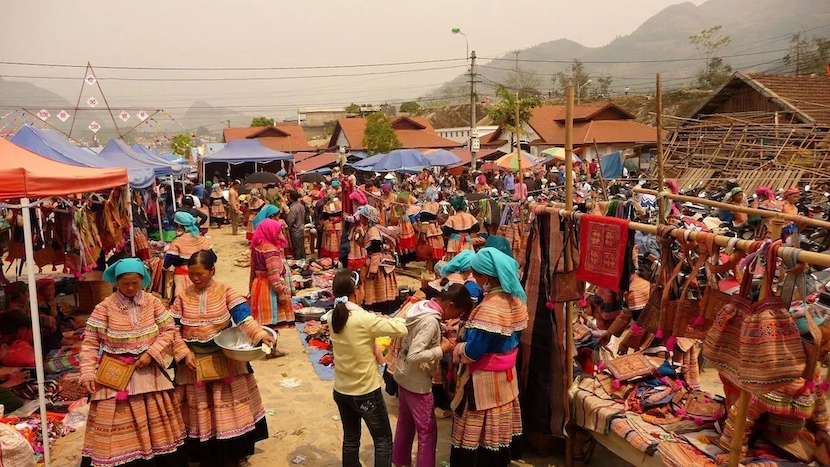
#4 Can Cau Market
One of the most famous highland markets in the Northwest is the Can Cau market in Si Ma Cai district, about 100km from Lao Cai city center. This market usually meets every Saturday morning, where the local products of the Mong, Giay, Hoa, etc. ethnic groups are exchanged and sold.
#5 Bac Ha Market
Bac Ha Market is one of the most famous markets in the Northwest, located in the center of Bac Ha town, about 70 km from Lao Cai city. The market usually takes place on Sundays every week, buying and selling local products and gathering the quintessence and cultural characteristics of the Mong, Tay, and Nung ethnic groups.
2.9. Ethnic Villages
With majestic mountain ranges, lush green valleys, and seemingly endless fields interspersed with ancient villages, Northwest Vietnam is not only an ideal destination for those seeking peace but also a place to explore the wonders of nature and ethnic culture.
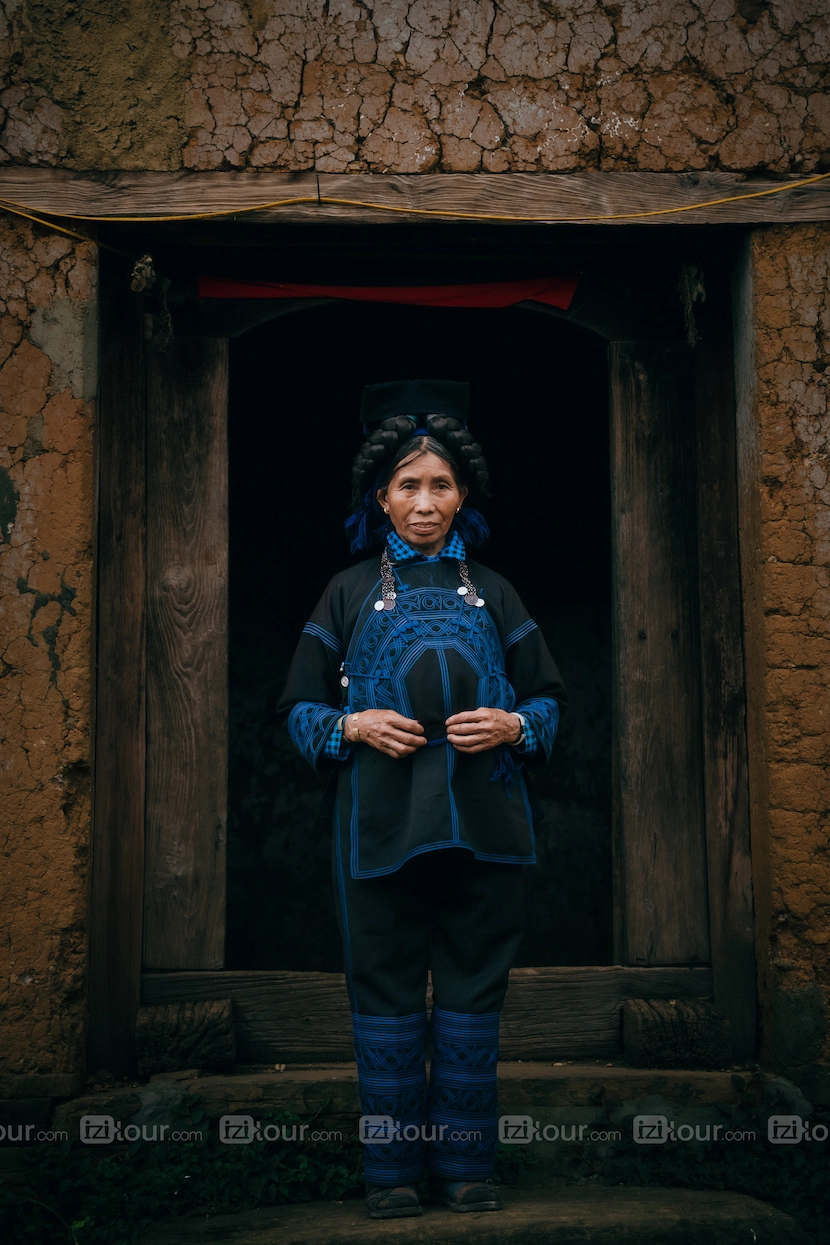
#1 Cat Cat Village
Cat Cat is one of the beautiful villages in Lao Cai province, Northwest Vietnam. This village is located at the foot of Hoang Lien Son mountain, San Sa Ho commune, Sapa town. There are stilt houses, small homestays, and cafes with mountain views around poetic streams. Come here to enjoy the peaceful scenery at the meticulously decorated cafes, enjoy specialties or simply stroll along the streets, learn about the unique culture of the H'mong people.
#2 Ta Van Village
Ta Van is also one of the most beautiful villages you should visit during a Northwest Vietnam tour. Ta Van village is located in Ta Van commune, Sapa district. A beautiful village with rustic earthen-wall houses of the Mong, Giay, and Red Dao ethnic groups living here, creating a vast, pristine picture of mountains and forests combined with breathtaking terraced fields. Especially, Ta Van village attracts many tourists by the suspension bridge across the stream.
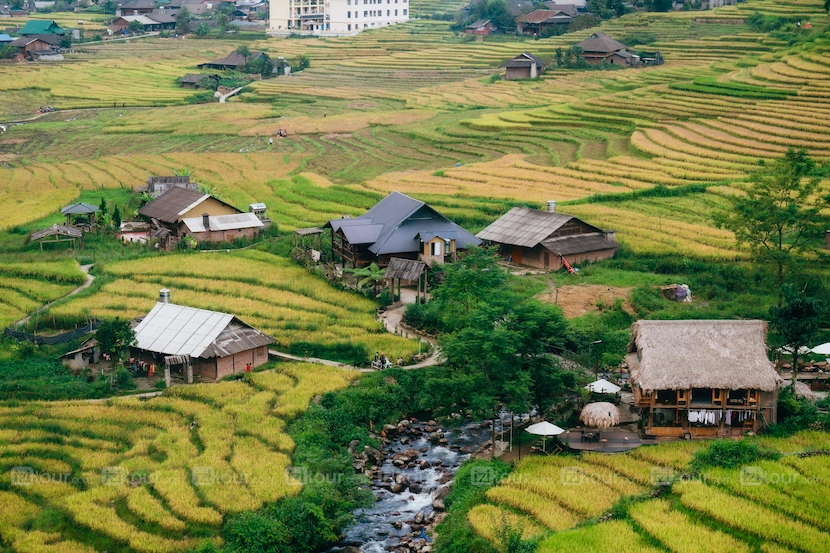
#3 Luot Village
The road to Luot Village (Son La) stretches along crystal clear streams, interspersed with emerald terraced fields and fragrant pine forests swaying gently in the mountain breeze, whispering tales of ancient traditions. At every turn, charming villages of the Thai ethnic people emerge, their traditional stilt houses nestled harmoniously into the terrain, inviting you to experience the rich tapestry of rural Vietnamese life.
#4 Lim Mong Village
The way to Lim Mong Village must pass through the Thai village near Nam Co stream, with Lim Thai stilt houses scattered along the road. Over the poetic suspension bridge, you will reach the small, thread-like roads sloping up the mountain, where Lim Mong village is located halfway up the mountain. Lim Mong is a Mong village. From the top of Lim Mong, you can admire a magnificent natural picture of majestic mountain ranges along with lush green terrace fields.

#5 Cu Vai Village
Cu Vai Village is known as the village in the clouds because of its location on top of a mountain, covered in clouds all year round. Looking down from above, the village looks very flat even though it is on top of a mountain. The village is not too big but is very easy to travel because there is only a straight main road. The whole village has about 50 houses running along both sides of the main road. Thanks to its hidden location, this place still retains the unique features of Mong culture.
2.10. Thac Ba Lake
Located in the territory of Yen Binh and Luc Yen districts, Yen Bai province, Thac Ba Lake is likened to "Ha Long on the mountain" with large and small green islands reflecting on the water surface and a beautiful suspension system hidden deep in the limestone mountains.
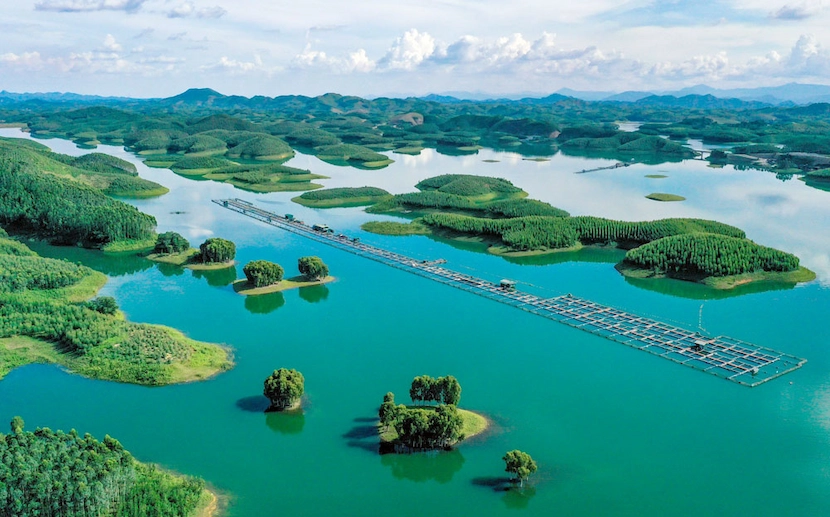
Taking a boat on Thac Ba Lake, visitors not only feel the fresh, cool air from the water and wind but also immerse themselves in the generous nature, letting their souls drift into the dreamy sky and water, the gentle and endless mountains and islands. After a few hours floating on the water, visitors can visit Thuy Tien Cave, Xuan Long Cave, Cao Bien Mountain, Chang Re Mountain, Thac Ong God, and Thac Ba Temple. You can also go upstream of the Chay River to Ngoc Luc Yen land to visit Sao Pagoda Cave, Dai Cai Temple, Khai Trung Green Plain, etc., bearing the unique cultural features of the Tay and Dao ethnic groups.
3. Northwest Vietnam Itinerary
Option #1: Northwest Vietnam Itinerary 5 days
Brief Itinerary: Hanoi - Nghia Lo - Tu Le - Mu Cang Chai - Sapa
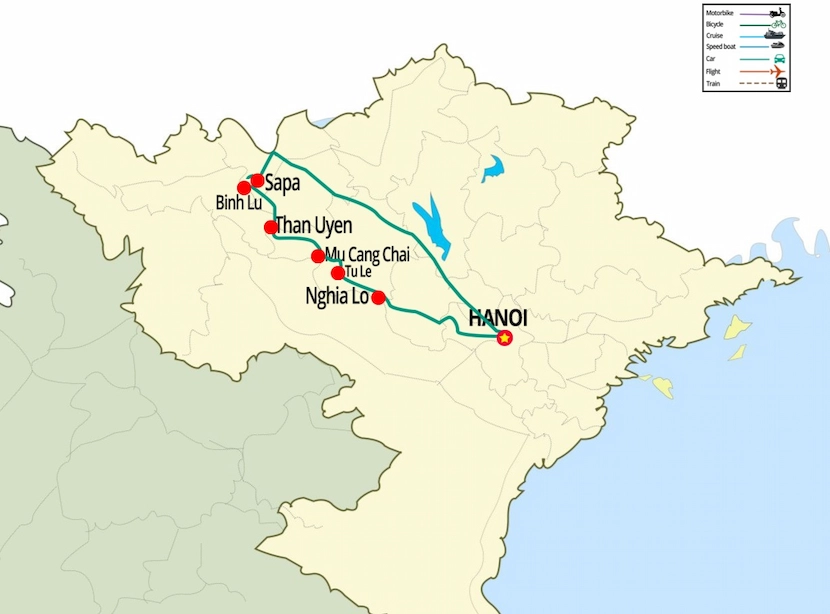
If you have limited time but still wish to cover must-see attractions in Northwest Vietnam, this itinerary is a good choice to consider. This Northwest Vietnam 5-day itinerary will take you off the beaten path to meet local ethnic groups, immersing you in the majestic pictures of wide-stretching lush green or golden rice terraced fields and the tranquil beauty of natural scenery here. Your discovery starts in Hanoi, where you will have a chance to visit the famous Hanoi Old Quarter with a lot of things to see, such as Hanoi Great Cathedral, Hoan Kiem Lake, Train Street, Hoa Lo Prison, etc. The next days are for venturing into Northwest regions, where you will experience the transition from urban landscapes to rural beauty. The route then takes you through Nghia Lo, Tu Le, and Mu Cang Chai, renowned for its breathtaking terraced rice fields that change colors with the seasons. Your adventure continues to Sapa, a picturesque town nestled in the Hoang Lien Son mountains. Here, you'll have the opportunity to interact with local ethnic minorities such as H'mong, Dzay, Tay, Phu La, etc., explore vibrant markets, and go trekking on marvelous terrace fields. That will be the end of your trip, you come back to Hanoi.
Option #2: Northwest Vietnam Itinerary 7 days
Brief Itinerary: Hanoi - Nghia Lo - Tu Le - Mu Cang Chai - Lai Chau - Sapa - Bac Ha
Day 2: Visit Hanoi attractions
Day 3: Hanoi - Nghia Lo
Day 4: Nghia Lo - Mu Cang Chai
Day 5: Mu Cang Chai - Lai Chau - Sapa
Day 6: Sapa - Bac Ha
Day 7: Bac Ha - Hanoi

Your adventure begins in Hanoi, where you will spend two days admiring the unique blend of modern and ancient atmosphere of the city. The first day will be spent for walking around, the second day allows for a deeper dive into Hanoi's top attactions including Ho Chi Minh Complex, Temple of Literature, train street, watching water puppet shows, etc. From the third day, you will start exploring mountainous areas with the first place Nghia Lo. This leg of the journey showcases the gradual transition from lowland to highland sceneries. Then, the route on day four is to Mu Cang Chai, which is famous for its recognition in the top 10 most beautiful rice terrace fields in the world,which are particularly stunning in September and October. The fifth day takes you through Lai Chau to Sapa, offering diverse mountain views and opportunities to encounter various ethnic minority groups. Sapa, a former French hill station, serves as a gateway to understanding the cultures of the Hmong, Dao, and other local communities. Your journey then continues to Bac Ha, which is known for its vibrant Sunday market and as home to the colorful Flower Hmong people. This provides another fascinating glimpse into the traditional ways of life in the mountains. The itinerary concludes with a return to Hanoi.
Option #3: Northwest Vietnam Itinerary 9 days
Brief Itinerary: Hanoi - Nghia Lo - Tu Le - Mu Cang Chai - Lai Chau - Sapa - Bac Ha - Hai Phong - Lan Ha Bay
Day 2: Hanoi sightseeing
Day 3: Hanoi - Nghia Lo
Day 4: Nghia Lo - Mu Cang Chai
Day 5: Mu Cang Chai - Lai Chau - Sapa
Day 6: Sapa - Bac Ha
Day 7: Bac Ha - Hanoi
Day 8: Hanoi - Hai Phong - Lan Ha Bay
Day 9: Lan Ha Bay - Hanoi
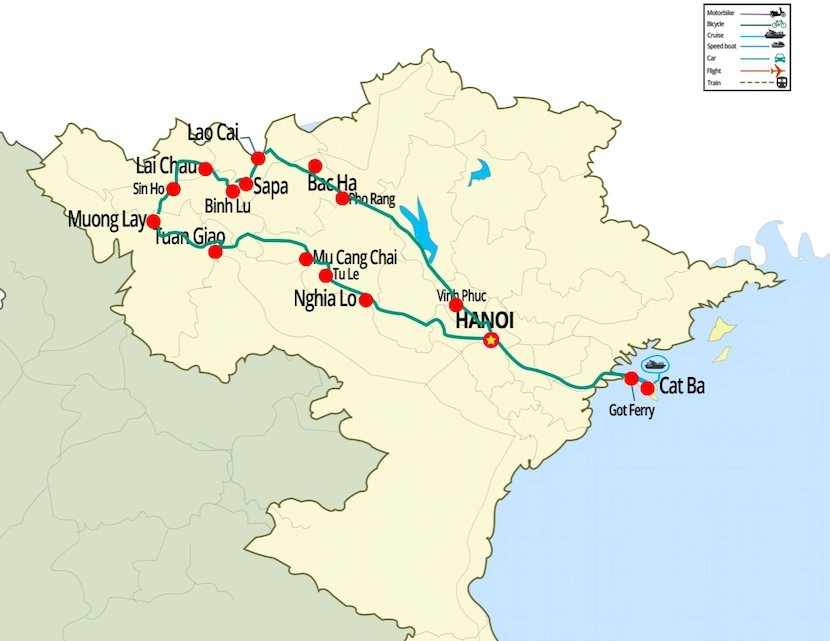
This itinerary may look almost the same as the 7-day one, but it adds a coastal dimension to your journey, which is a difference. After returning to Hanoi from the mountains, you'll stay overnight in Hanoi, then embark on a new adventure to Hai Phong and the stunning Lan Ha Bay. This less-crowded bay, compared to Halong Bay, offers mesmerizing seascapes of limestone karsts rising from emerald waters. Your day in Lan Ha Bay provides opportunities for kayaking, cooking demonstrations, swimming, relaxing on pristine beaches, squid fishing, and so on. This serene coastal experience serves as a perfect contrast to the mountain landscapes you've experienced earlier.
Option #4: Northwest Vietnam Itinerary 11 days
Brief Itinerary: Hanoi - Nghia Lo - Tu Le - Mu Cang Chai - Dien Bien Phu - Lai Chau - Sapa - Bac Ha - Thac Ba - Bai Tu Long Bay
Day 2: Visit Hanoi
Day 3: Hanoi - Nghia Lo
Day 4: Nghia Lo - Mu Cang Chai
Day 5: Mu Cang Chai - Dien Bien Phu
Day 6: Dien Bien Phu - Lai Chau
Day 7: Lai Chau - Sapa
Day 8: Sapa - Bac Ha
Day 9: Bac Ha - Thac Ba
Day 10: Thac Ba - Hanoi - Bai Tu Long Bay
Day 11: Bai Tu Long Bay - Hanoi
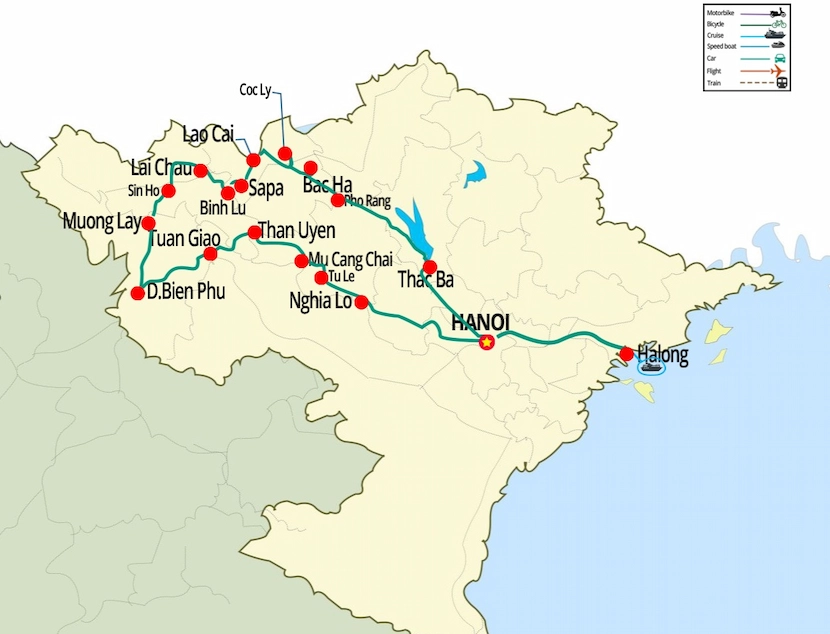
This comprehensive 11-day journey offers an in-depth exploration of Northern Vietnam, combining the vibrant capital with the diverse landscapes, rich history, and cultural tapestry of the Northwest. A notable addition to this itinerary is the visit to Dien Bien Phu, a site of great historical significance known for the decisive battle that ended French colonial rule in Vietnam. It will add a layer of historical context to your cultural exploration. Then, you will head to Lai Chau, Sapa, and Bac Ha; these places allow you in-depth encounters with various ethnic minority groups such as Lao Tien, Lu, Black H'mong, Red Dzao, Dzay, etc. and their distinctive cultures. The inclusion of Thac Ba Lake, one of Vietnam's largest artificial lakes, offers a unique landscape different from the mountain sceneries you've experienced earlier. This itinerary provides a comprehensive view of Northern Vietnam's diversity, from its war-torn past to its natural wonders and vibrant present. It is ideal for those who want to understand the Northwest Vietnam region deeply, and it promises a rich, multifaceted experience of Vietnam's northern territories.
We hope that the information above can help you out with your Northwest Vietnam travel plans. If you need more detailed advice from a local travel agency, IZITOUR.com can help! Feel free to leave a comment below or email us at [email protected] or WhatsApp at +84 382 536 266, our travel experts will get back to you with the best quote and detailed itineraries.
Read more:
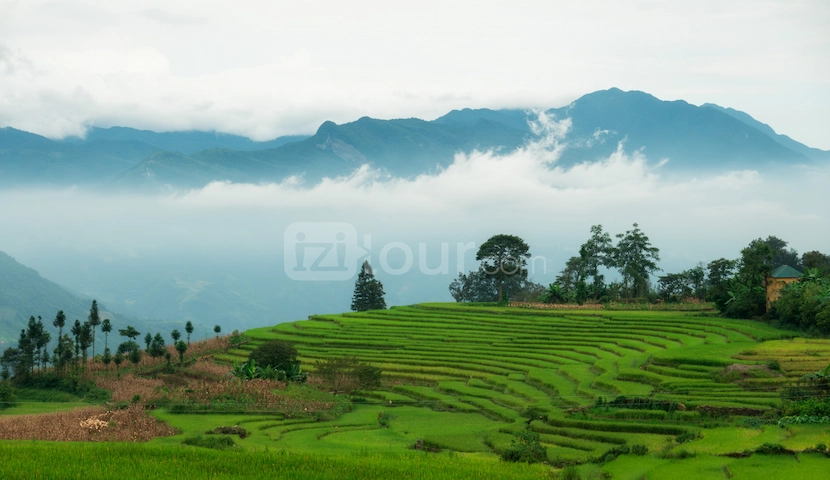







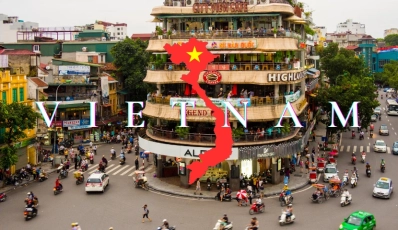
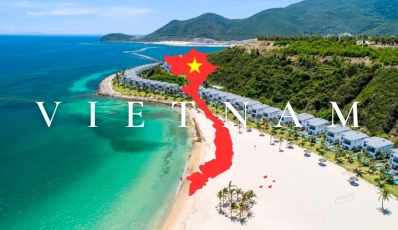
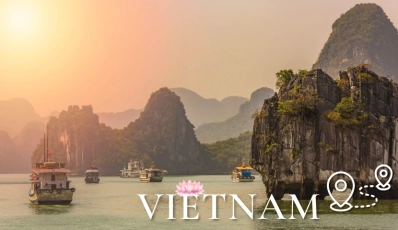
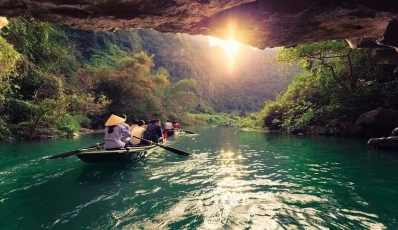
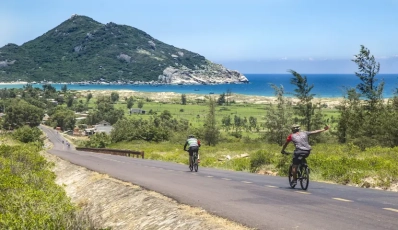
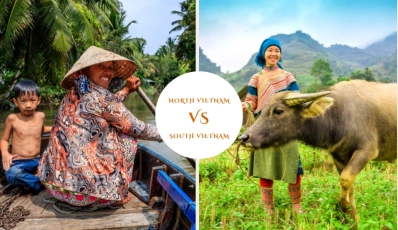
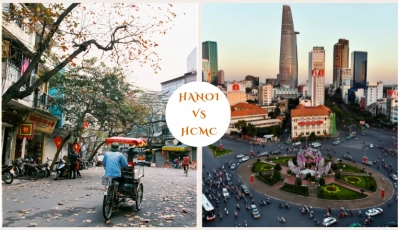
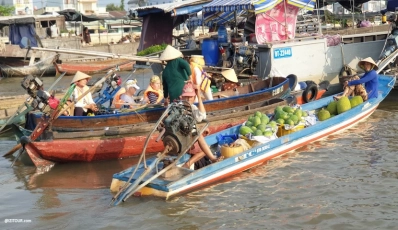
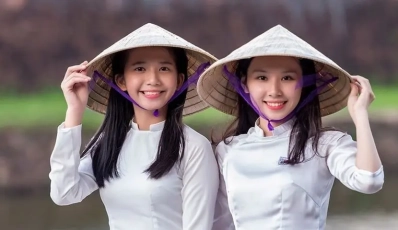




 TRAVELERS' CHOICE 2025
TRAVELERS' CHOICE 2025 



08 Comments
United States
Vietnam
Germany
Vietnam
Iceland
Vietnam
Netherlands
Vietnam
Write Reply